Introduction
Welcome back to our fitness journey, where we continue to explore science backed, effective and safe workout strategies that can be done at home, vehicle touring, camping or travelling – all with minimal and portable equipment.
Today, we turn our focus to a topic riddled with myths and commercial exploitation: abs and core exercises. Building on our previous discussions about biomechanics and optimal anatomical motion, let’s dive into the realities of abs and core training and finish with the most effective and safest core exercises for seniors and all age groups – they are simpler than you may think.
Read this post in conjunction with the Mobility and Flexibility Post. There are mobility and core strength overlaps in both.
The Truth About Abs
The fitness industry is awash with promises of quick-fix six-pack abs solutions. But to set the record straight – the abs (rectus abdominis) is ONE muscle with all fibers running from the origin to the insertion. The appearance of muscle separation is due to tendinous intersections that we are all born with. There is no ‘separate’ upper and lower abs.

Genetics will determine if you can even get a six pack with a perfect diet and training. Do you see a defined six pack in the image below of Arnold Schwarzenegger in his prime? He has a 4 pack. What about the other guy with a 10 pack? Genetics plays a major role.
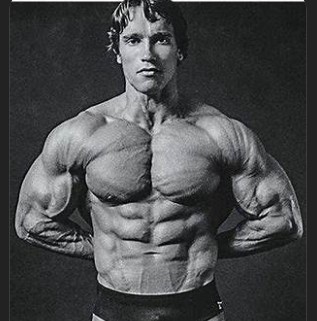
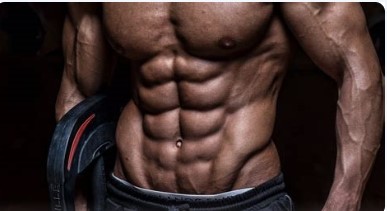
The Abs are arguably the most misunderstood muscle, and yet somewhat ironically, one of the simplest to exercise and develop. The abs, primarily, do one thing – spinal flexion.
This website, although geared to touring, camping and travelling workouts for the aging population, still follows fundamental biomechanics principals for optimal exercises. That is, and to reiterate:
- All muscles pull / contract from their insertion towards their origin – this is because the origin is always the more stable of the 2 ends
- Target muscles are activated to a greater degree, and more safely, from exercises with a natural anatomical full range of motion that is opposite to the resistance direction
See this previous post for our exercise protocols.
……. and this post for our workout approach and equipment while touring / camping, travelling or at home.
With the right portable equipment, you can achieve a quality workout anywhere and at any age.
As you can see in the image below –the abs are not connected to the legs.The origin (A) is on the pubic bone and the insertion (B) is on the lower front of the ribcage.
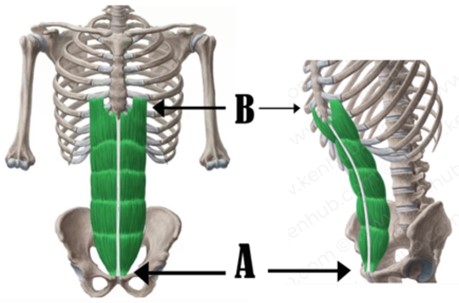
The primary role of the abs is to flex the spine. This means that exercises like leg raises, planks and many other traditional or popular exercises work the abs isometrically (stabilizing only), not dynamically. Understanding this distinction is key to effective abs and core training.
Another misconception with the abs, is that exercising them will help reduce belly fat.
Exercising the abs properly will strengthen and develop the muscle but will not reduce any layers of fat covering them. Visible abs are made in the kitchen - not by how many sets and reps you do.
Your individual genetics determines how fat is distributed over your entire body – in some areas more than others. When you lose fat, via burning more calories than you ingest, then your overall body fat diminishes in the reverse order to which it accumulated.
Debunking Popular Abs Exercises
Let’s have a look at 3 of the myriad of ‘popular’ abs exercise – hanging leg raises (first image), the plank (second image) and the reverse crunch (third image).
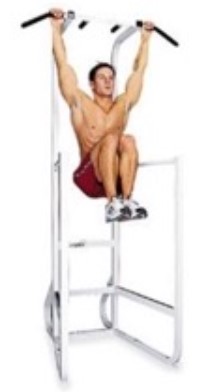

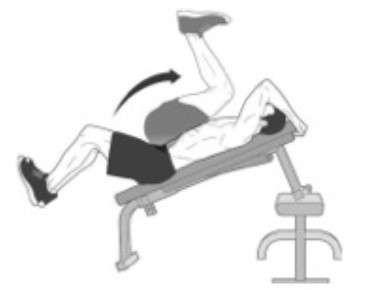
A brief analysis of these exercises follows:
Hanging Leg Raise: This is a hip flexion exercise. The muscles that enable hip flexion are the hip flexors, hence their name. The abs and the core only work to stabilize the torso while raising the legs.
The Plank: This is purely an isometric (stabilizing) exercise for all contributing muscles as there is no movement at all. The plank is a good option if any spinal or hip flexion causes discomfort.
Reverse Crunch: This is the best of the 3 examples because there is at least some torso flexion. The problem with this exercise, which reduces its effectiveness, is that it attempts to bring the pelvis (where the origin is), via lifting the legs, towards the ribcage (where the insertion is). This is one of very few muscles that enable an ‘origin to insertion’ movement. However, lifting the legs engages the hip flexors, which interferes with the efficient contraction of the abs.
Before continuing, we reiterate that there is nothing 'wrong' with these or other abs exercises or any muscle group exercise that is different to what we recommend - providing they are done with perfect form, and you are aware of the target muscle activation constraints and injury risks.
Age Free Strength is all about understanding biomechanics, physics and neurology to determine and to apply the optimal exercises for efficient and effective target muscle activation and joint safety.
Understanding the Core Beyond the Abs
Contrary to popular belief, the core is a lot more than just the abs. It includes the obliques, erector spinae (sometimes mistakenly considered as the ‘lower back’), transverse abdominus, multifidus, diaphragm and pelvic floor muscles – with each playing a role in our overall core strength and stability. Here’s a summary of the 4 major core muscles, and their functions. We will delve into these with our optimal exercises further down in this post:
- Rectus Abdominis: See the above sections. Often referred to as the ”abs” or “six-pack” muscles, these run along the front of the abdomen and are responsible for flexing the spine.
- Erector Spinae: A group of muscles and tendons running along the spine, these are critical for maintaining upright posture and for extending the back.
- Internal and External Obliques: Located on the sides of the abdomen, these muscles help with rotation (external obliques) and lateral flexion (internal obliques) of the spine.
- Transverse Abdominis: This is the deepest abdominal muscle and acts like a corset, wrapping around the spine for protection and stability.
An effective core workout addresses all these areas, ensuring a balanced approach to core strength.
The hip flexors, particularly the psoas major, also have a significant impact on posture and spinal alignment, and their strength and flexibility are important for overall core function. So, while hip flexors are not core muscles in the strictest sense, their health and functionality are closely linked to core strength and stability – but for this post we will omit them as part of the ‘core’ muscle groups.
The images below show the primary core muscles (in addition to the abs) – the internal and external obliques (first image), the transverse abdominus (second image) and the erector spinae (third image).
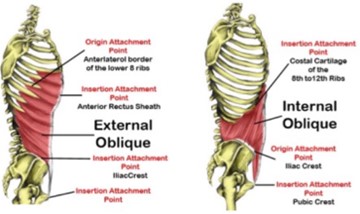
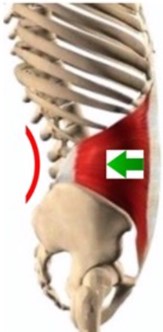

Become a Member to see how these exercises fit into our Routines.
The Best Abs and Core Exercises
So, what are the best abs and core exercises? As alluded to above its simpler than you may think.
The Number 1 Abs Exercise
A study was done in 2005 (published in the Journal of Strength and Conditioning) where the degree of ab muscle activation – overall and the fibers closer to the insertion (upper portion of the fibers) versus the same fibers closer to the origin (lower portion of the same fibers) – was evaluated via Electromyography (EMG) analysis.
This study was done with 7 exercises, including ab scissor kicks, abs roller, various machines and the crunch. Apart from 1 machine (a prototype that never made it to market), the crunch showed the highest degree of fiber activation. The abs roller was second.
An interesting outcome of the study was that, in all exercises, there was the same ratio of upper/lower fiber activation with the upper fiber portions always the greater. This is because the spine flexes the most where the insertion is (lower rib cage). It shows that there is no real value in doing ‘lower abs’ exercises such as leg raises – firstly because there is no ‘lower abs muscle’, secondly because the Abs are not connected to the legs, and lastly because most of those popular lower abs exercises only work the abs isometrically.
So, the number 1 ab exercise is the Abs Crunch (when done correctly), demonstrating that this basic movement, producing simple spinal flexion, is all that is necessary to optimally stimulate the abs muscle.
The gif image below shows the correct form for a standard crunch.
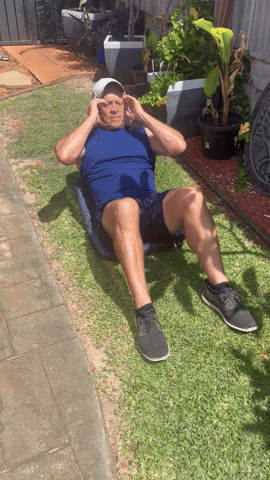
Exercise Notes:
- It’s ok to support your back on a slope up to around 30 degrees (or even more if you have strength or mobility issues) – in the image I’m using a folding stadium seat as my back rest. Many people find it too hard to crunch effectively from a horizontal position – where it can turn into a neck flexing exercise rather than abs flexing exercise. When camping we often do this exercise on the bed prior to getting up with our pillows positioned under our back.
- Bend your hips by raising your knees to around 45 degrees.
- Crunch your torso down to your pelvis. This is not a ‘sit-up’ where you flex the hips. Your hips stay still, and you flex your spine.
- When you straighten your spine, think of it as ‘uncoiling’ while feeling tension in your Abs – don’t just release.
- This is a simple, effective and safe exercise with the correct form.
There is an equal ‘number 1’ abs exercise. It’s a kneeling or seated cable or resistance band crunch with the cable or bands set above and behind your head. The issue with this version is that it’s best done on a bench with back support and in a home gym as we don’t carry a bench around with us while touring and camping. The gif image below shows what the kneeling version looks like with bands and without a bench seat.
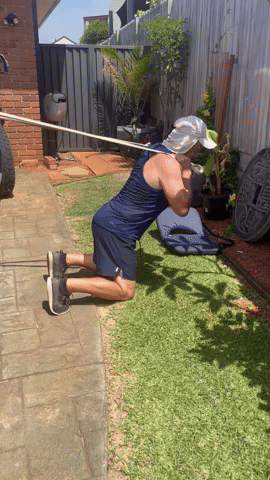
Exercise Notes:
- I find this exercise a bit uncomfortable for my feet without a bench seat – which is why I typically just do the laying crunch
- If you do this version note the angle of the band (or cable) resistance which should be roughly perpendicular with your back at the top of the range of motion
- Again, the abs flex the spine, and this is a spine flexion exercise – not a hip flexion exercise – so don’t bend your hips
Don’t Ignore the Spine Muscles
The next core muscle group we exercise is the erector spinae, which are often erroneously referred to as the lower back muscles. The reason for that is because the lower end of these muscles is all you see. This muscle group runs right up the spine with most of it hidden under other muscles.
The origin of the erector spinae muscle group is a broad tendon attached over a large area of the lower back. There are multiple insertions from the rib cage to the base of the skull. It is the opposite muscle group to the abs and therefor, its primary role is to extend the spine.
The best exercise for the erector spinae is also simple, the Spine Extension – but it does take a bit of practice to isolate it properly. See the gif image below.
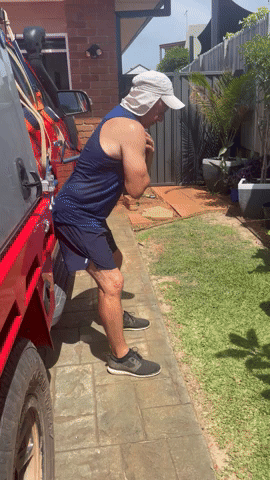

Exercise Notes:
- As you can see, the movement is the same as the crunch, except with this setup, the load is applied to extending the spine rather than flexing the spine
- Your upper bodyweight, as the resistance, will be enough for a while. You will be surprised how challenging this is and you will feel it as you approach 20 reps
- If you think you need more load, simply hold a weight in your arms – but be careful with adding weight
- Also, as you can see, it will take some time and practice to only bend your spine and not your hips
The Obliques
As noted in the above sections and images, the external obliques rotate the spine, and the internal obliques produce lateral flexion of the spine.
I rarely exercise the internal obliques (with side bends) which are mostly for lateral stabilization. This is one exception where we say that daily living, such as carrying things with one arm, provides enough exercise for this muscle. It is also challenging to isolate and flex the spine laterally – and it comes with more than average injury risk.
The external obliques, however, do have an optimal range of motion exercise that provides benefits from a functional standpoint. This exercise is the Torso Rotation.
As for all Age Free Strength optimal exercises, there is an ideal setup and execution of this exercise as per the gif image below.
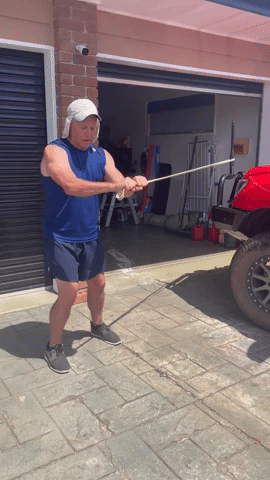

Exercise Notes:
- There is no need or advantage in going high to low or low to high (wood chops etc), simply rotating horizontally is all that is required, similar to swinging a baseball bat
- Set the resistance, either with bands or cables (or Unitree Pumps) at upper chest height. This enables the resistance direction to be opposite the anatomical motion – one of the optimal exercise principles.
- It is a torso rotation exercise, not an arm movement exercise. As you can see the arms stay locked in position with the obliques doing the rotation work
- Also, don’t over rotate in either direction. The middle 80% is adequate and safe
Transverse Abdominus
The last of the major core muscle groups that we exercise is the Transverse Abdominus. This muscle is located 3 layers down – beneath the external and internal obliques. It mostly connects to and from fascia (connective tissue) with minimal direct connection to bone.
The Transverse Abdominus acts as sort of a ‘girdle’ for the abdomen, provides spinal support, assists in breathing and participates in torso coordination. Although you can’t see this muscle it does have some functional importance.
There is one specific exercise that directly strengthens this muscle – the abdominal vacuum.
….. and no, that’s not me in the image below. It’s Frank Zane, one of the great bodybuilders in the late 1970’s and before the muscle mass behemoths dominated the sport. As you can see, he was renowned for the vacuum pose.
Doing the abdominal vacuum on a regular basis, either lying down or standing, can keep that part of your core strong, your lower back supported, and it helps flatten your belly.
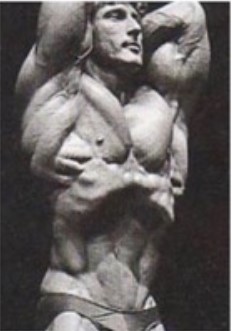

Exercise Notes:
- You can’t do a vacuum effectively if your lower back (tailbone) is not slightly arched and it impossible to flex your abs while simultaneously pulling your abdomen inward
- The best way to learn how to do this is by first lying on your back, on a floor mat while elevating your tailbone with a pad. Allow your lumbar spine to arch upward. Then exhale and, without inhaling, try to pull the abdomen inward, toward your spine. The more you attempt this, the more your coordination will improve.
- A partial vacuum can be achieved without a full exhale, but a full vacuum requires a full exhale
- Once you have mastered doing this while lying on your back, practice it while standing and placing both hands on a shelf or other firm surface in front of you, about the height of your chest. Gently push downward with your hands on the shelf (which helps you lift your chest and arch your Lumbar spine), then draw your abdomen inward – holding it for about 5 seconds. You may feel a muscle contraction in your lower back, on each side of your spine. That’s the origin of the transverse abdominus.
Become a Member to see how these exercises fit into our Routines.
Conclusion
Hopefully, this post will help you understand what the abs and core really are and how best to exercise them – effectively and safely.
Understanding biomechanics and a bit of physiology exposes the myriad of mis-informed exercise, ‘belly fat and equipment gimmicks’ that are trying to exploit the population for commercial gain.
If this post has stimulated your interest in the science of biomechanics – checkout the Brig20 Program and The Physics of Fitness Course.
Next Post – Mobility, Flexibility and Balance
In the next post we will divert a bit from resistance exercise and focus on mobility and flexibility (another topic that is riddled with commercial exploitation) as part of how we live a vibrant and healthy touring, camping and travelling lifestyle.
In the meantime, we have developed a Members Area with a one-off lifetime subscription, with images, written descriptions and video demonstrations - of all the optimal exercises, exercise options, equipment setups and various routines.
To keep this subscription simple, it will come with a lifetime access fee of AU$50 - which will include all of the periodic additions as we evolve.
Feel free to leave a comment or ask any questions. We will also start a questions and answers newsletter/email - STAY TUNED!!!
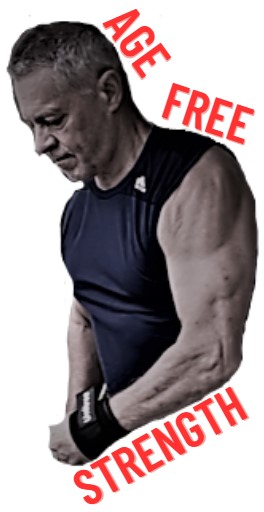
Found this article helpful and scientific. Thanks team.
Thanks Yogi. A lot more to come.